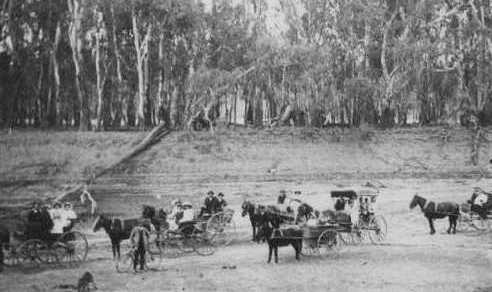
Dry river bed of the Murray river at Myall near Kerang, Victoria.1914.
During the Federation drought it stopped flowing for about 6 months. (1)
Image enhanced from - Source: Courtesy of the State Library of New South Wales. (2)
 Select an article on this page.
Select an article on this page.
#: Definition of a Drought in Australia.
1: Australia denies the image as being drought-prone 1921 .
2: Did Australia's longest river , ever stop flowing ?
3: Historical perspective of a drought prone Australia
4: A 1889 publication of Australian Droughts 1782 to 1889.
5: Drought related excerpts from Newspapers. 1803 - 1889
6: A brief synopsis of Australian Droughts 1800 to 1900
7: Australia's Longest Drought 1958 to 1968.
8: Australian Drought Records 1857 to 2008
9: Latest Drought Updates.
Other Drought related articles.
Henry Lawson: The Australian Drought 1900
Drought and Bush Fires in Victoria
1851 Black Thursday
Chronology of Australian Major Bush fires
Melbourne dust storm, 8 February 1983
Drought.
A drought is a prolonged, abnormally dry period when there is not enough
water for the users normal needs.
Drought is not simply low rainfall; if it was,
much of inland Australia would be in almost perpetual drought. Because people
use water in so many different ways, there is no universal definition of
drought.
Meteorologists monitor the extent and severity of drought in terms of
rainfall deficiencies. Agriculturalists rate the impact on primary industries,
hydrologists compare ground water levels, and sociologists define it on social
expectations and perceptions.
Source: Australian Government - Bureau of Meteorology
1921:
Australia denies the image as being drought-prone.
Politicians and bureaucrats were eager to deny the image of Australia as drought-prone, lest this deter immigrants.
H. S. Gullett, the Commonwealth Superintendent of Immigration, was quoted as saying:
“Many thousands of Australians go abroad every year on business or pleasure.
The Commonwealth Immigration Office appeals to every one of them to embark with the resolve that he will on all possible occasions speak well of Australia.
Let none of them speak evil. Such words as 'drought' should be thrown overboard as the vessels put out to sea.”
(Sydney Morning Herald, 6 June 1921. )
1990:
Drought is part of the natural variability of the Australian climate.
" The 1990s saw formal Government acknowledgement that drought is part of the natural variability of the Australian climate, with drought relief for farmers and agricultural communities being restricted to times of so-called “exceptional circumstances”. In other words, the agricultural sector was expected to cope with the occasional drought, and relief would be available only for droughts of unusual length or severity."
Source: Bureau of Meteorology Australia http://www.bom.gov.au/lam/climate/levelthree/c20thc/drought.htm
2008:
Australia bans word 'drought' as too upsetting for farmers
The word "drought" makes farmers feel depressed and should be replaced with "dryness", a panel of Australian government experts has said.
Source: Report by the Drought Policy Review Expert Social Panel
"'Cattle Kings' ye call us, then we are Kings in grass castles that may be blown away upon a puff of
wind " Patrick Durack 1878

The Murray river - Australia's longest river 2375 kilometres.(4)
Did the Murray river , Australia's longest river , ever stop flowing ?
Murray-Darling Basin Commission water
resources manager Andrew Close said if the Murray still had its natural flow, it would have probably
stopped flowing this year ( 2006 ) , as it did in 1850 , 1902 - during the Federation drought when it stopped flowing for about 6 months , 1914, 1915 and 1923, while the Darling River dries up more
frequently.
Source:
The Australian
November 11, 2006 12:00am
"...if all dams and weirs did not exist and no water was extracted from the system....the Murray would
have ceased flowing during the more severe droughts, including the current dry period " ( 2008 ).
" In the last couple of years a continuous flow along the length of the Murray has been maintained
by drawing upon water stored upstream, particularly in Hume and Dartmouth Reservoirs when other
tributary inflows are low. " Source: MDBC Murray System Drought Update No. 15 – September 2008
Australia is prone to drought because of its geographic location.
Much of Australia lies in a latitude belt that is under the influence of an atmospheric phenomenon known as the subtropical high.
Just outside of the tropics in each hemisphere lies a swath of the globe where air frequently sinks toward the Earth’s surface from higher in the atmosphere.
The air warms and dries as it sinks, creating semi-permanent zones of high air pressure at the surface.
These subtropical highs are areas of stable, warm, and dry air that favour clear skies and little rainfall.
(In the Northern Hemisphere, several large deserts, including the Sahara, reside in the
latitudes of the subtropical high.).
Source: Current information about climate and the environment.
NASA Earth Observatory http://www.nasa.gov/ Accessed 1st July 2009

Persistent high pressure over most of Australia leads to low and often erratic rainfall. Drought tends to occur when the high pressure systems are more extensive than usual, excluding rain-bearing systems for lengthy periods of time.(5)
The Indian Ocean Dipole

A phenomenon known as the Indian Ocean Dipole (IOD) - a variable and irregular cycle of warming and cooling of ocean water - dictates whether moisture-bearing winds are carried across the southern half of Australia.
When the IOD is in its negative phase, a pattern occurs with cool Indian Ocean water west of Australia and warm Timor Sea water to the north. This generates winds that pick up moisture from the ocean and then sweep down towards southern Australia to deliver wet conditions.
In its positive phase, the pattern of ocean temperatures is reversed, weakening the winds and reducing the amount of moisture picked up and transported across Australia. So the south-east misses out on its usual quota of rain.
The IOD is commonly measured by an index that is the difference between sea surface temperature (SST) in the western (50°E to 70°E and 10°S to 10°N) and eastern (90°E to 110°E and 10°S to 0°S) equatorial Indian Ocean. The index is called the Dipole Mode Index (DMI).(7)
"We have shown that the state of the Indian Ocean is highly important for rainfall and droughts in south-east Australia. More than the variability associated with the El Nino/La Nina cycle in the Pacific Ocean, the Indian Ocean Dipole is the key factor for driving major south-east Australian droughts over the past 120 years (8)."
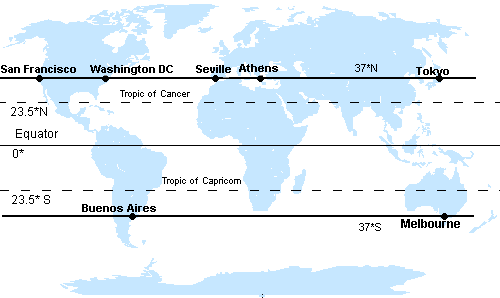
The IOD has been in its positive or neutral phase since 1992, the longest period of its kind since records began in the late 19th Century

Many drought episodes in the eastern and northern part of the Australia are linked to El Niño episodes.
 |
| El Niño Years | |||
| 1902-1903 | 1905-1906 | 1911-1912 | 1914-1915 |
| 1918-1919 | 1923-1924 | 1925-1926 | 1930-1931 |
| 1932-1933 | 1939-1940 | 1941-1942 | 1951-1952 |
| 1953-1954 | 1957-1958 | 1965-1966 | 1969-1970 |
| 1972-1973 | 1976-1977 | 1982-1983 | 1986-1987 |
| 1991-1992 | 1994-1995 | 1997-1998 | 2002-2003 |
| 2006-2007 | |||
 |
El Niño Drought affected areas highlighted in orange.
Source and Images courtesy Bureau of Meteorology Australia
Annual rainfall distribution over Australia in the period 1901 to 1999.
The distribution of annual rainfall over Australia in the period 1901 to 1999, by decade.
Areas coloured blue fall in the upper tercile (i.e. wet) for the decade concerned, while the brown areas fall in the lower tercile (dry).
| Above Average | Average | Below Average |
 |
 |
| 1901-1910 | 1911-1920 |
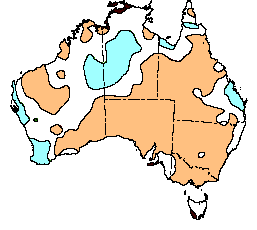 |
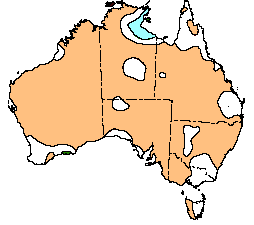 |
| 1921-1930 | 1931-1940 |
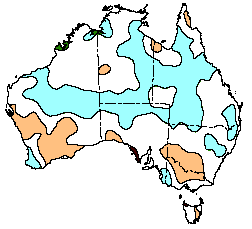 |
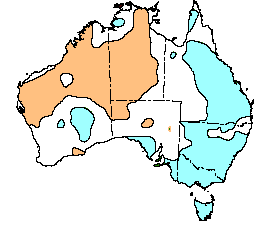 |
| 1941-1950 | 1951-1960 |
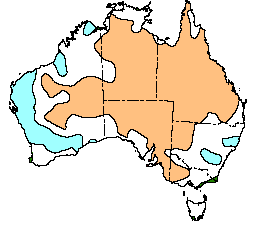 |
 |
| 1961-1970 | 1971-1980 |
 |
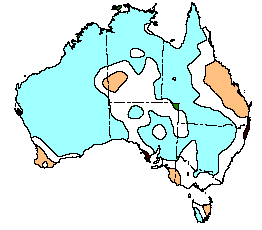 |
| 1981-1990 | 1991-1999 |
The Brisbane Courier Friday 11 October 1889
THE PREDICTED DROUGHT. Australian weather statistics 1782 - 1889.
" In order to throw some additional light on
the above question, I will furnish a few condensed Australian weather statistics of the last
107 years, and if anyone can found a positive
forecast on them he is welcome to do so ; all
that I can see in them is the simple fact that
floods and droughts alternate out here with
"lucid intervals" of ordinary settled and
moderately wet or dry weather.
Captain Cook
in 1770 says little about the weather. Dampier
in 1690 or thereabouts was equally silent.
Captain Matthew Flinders reports drought and
bush fires from 1782 to 1792.
There was a
great drought in 1797 for 100 miles round
where Melbourne now stands ; 1799 to 1806 were
very wet years, and in 1806 the floods culminated by a rise of 101 ft. at Windsor,
on the Hawkesbury River.
The crops were destroyed, wheat rose to 80s. a bushel, and a
famine prevailed.
The excessive rain kept on till
1810, but 1811 cut it short, and was so dry
that water was worth 8d. per bucketful in
Sydney.
This drought was sharp but short,
and there was plenty of increasing rain for
years afterwards, till in 1820 the Hunter
River rose 37ft.
Ten years now elapsed
without any more floods, and it was so dry
from 1826 to 1829 that water at last became
worth 4d. a gallon in Sydney. 1830 saw the
first flood for ten years.
Ordinary weather
followed till 1837, but 1838 and 1839 saw the
champion drought of the century. Stock were
all but exterminated. The Murrumbidgee is a
great river, 150ft. wide, 60ft. deep, and overflows its banks, like the Nile, when the head
snows melt, for five miles on each side to a
depth of 3ft. This gives a volume of water
equal to a river of 1450 ft. wide and 120 ft. deep,
and besides this it fills a group of lakes each
from seven to eighteen miles in diameter.
Yet this great river dried up so
thoroughly in 1839 that the fish died
and putrefied at the bottom of it.
I
make no comments on what such a drought
now would do to Queensland, and I am at
present only going for dry facts and bald
statistics.
1841 broke up this drought with the
champion flood of Queensland; the Bremer River
rose 70ft., and the Brisbane bar not being then
dredged, there was no quick "get away" for
the water, and it filled the lower story of the
commissariat stores here, and Ipswich was
very short of rations for some days.
Moderate
rain carried the colony of Now South Wales
(then the only one) on till 1849, when dry
weather began and lasted till May, 1851.
The
scattered bush fires of Victoria got " boxed"
into one mighty whole on 6th February, 1851
(" Black Thursday "), before a southerly hurricane
which sent smoke and leaves across Bass
Straits.
1852 brought a flood that swept Gundagai away and drowned the inhabitants ; 1853
saw great overflows of the Lachlan, Murrumbidgee, and Darling rivers, but not from local
rain ; 1854 was dry; 1855 and 1856, ordinary
weather; 1857 was a flood year, with three
months ceaseless rain from February to May.
Settled weather lasted till 1863, which, with
1864, both gave heavy flood. The weather
settled again till 1873 (bar a small drought up
North in 1866), which, with 1875, was very
wet, and gave a flood each.
Settled weather
again carne, with a small local flood in 1879-80 ;
1882 very wet: 1883 to 1886 very dry; 1887
very wet; 1888 very dry; 1889 moderately
wet.
Here we have 107 years of statistics,
and who can discern from them the
rule that guides the weather ? A matter
which enters so largely into our health
and comfort, happiness and prosperity,
that I hope to be excused for thus dwelling
upon it. ......
N. Bartley The Brisbane Courier 1889 "
Source: The Brisbane Courier Friday 11 October 1889
Reports of Drought by our Early Settlers.
Governor Arthur Phillip 1791
Governor Arthur Phillip wrote the following to the Colonial Secretary, the Right Honourable W. W. Grenville on 4 March 1791:

"From June until the present time so little rain has fallen that most of the runs of water in the different parts of the harbour have been dried up for several months, and the run which supplies this
settlement is greatly reduced, but still sufficient for all culinary purposes... I do not think it probable that so dry a season often occurs. Our crops of corn have suffered greatly from the dry
weather."
On 5 November 1791, the governor of this colony, Arthur Phillip, reported that the normally perennial 'Tank Stream' river flowing into Sydney Harbour had been dry for "some months".
It did not flow again until 1794. Phillip marks the start of the droughts in July 1790; no rain had fallen by August 1791 **
During the drought in 1814 Governor Macquarie had to import food to avoid what he called:
"the heavy calamity of very great scarcity, both of animal feed and of grain, if not in an actual famine."
Drought related excerpts from local Newspapers. 1803 - 1839

1803
The late drought has been severely felt in all parts of the Colony, and has been attended with
much loss to the gardener. In fact, vegetation was almost at a stand, and a great part of the feed,
for want of rain, perished in the ground. The crop of potatoes has turned out very indifferently ;
and the maize, but for the late seasonable rain, would have been equally unpromising :
We are happy to state however, that in all parts of the Colony, so manifest a change has taken place
in the latter, as to assure the grower of an abundant crop.
The Sydney Gazette and New South Wales Advertiser Sunday 29 May 1803
1811 March
The long-prevailing drought has destroyed every
hope of a maize crop, which is now unfortunately
past recovery. A scarcity of water has also been
the consequence, scarcely ever, before witnessed.
In Sydney the 'Tanks' have been, several weeks
empty, and those who, were in want of water
are obliged to collect it from small cavities in the
spring course above the 'Tanks', which has afterwards
been sold at from four-pence to six-pence
per pail. The month of March however has commenced
and rains are of course to be expected.
The Sydney Gazette and New South Wales Advertiser Saturday 2 March 1811
1811 October
The long succession of dry weather at the present season has heretofore been unexampled, and
the field and garden languish for the want of
rain
The last refreshing shower with which Divine Providence was pleased to favour us was upon
the 27th of August : it was very general, and gratefully acceptable throughout the various settlements,
its continuance was about 24 hours: since
which period however, we have scarcely had one
visiting shower.
From this, great cause the growing
wheat has in situations naturally dry received
much injury; while in moister grounds, that have
the advantage of a humid atmosphere the appearance
is far more promising.
The produce of the
late sown fields depends much upon the weather
for a few weeks to come, the farmers hope rain without which they can form no expectation
of the latter crop, nor save the season for planting
maize, some former disappointments in the crops of
which have been felt severely, as the rapid decline of
stock was among the certain consequences.
From the best information we can collect, so intense a
drought at this time of the year has not been witnessed
since the year 1789, when the new colonists
suffered a parching thirst; for several months, the
springs from which they had been before supplied
either failing totally, or yielding scarcely a sufficiency
to support nature, numbers of flying foxes
and squirrels, parrots, and birds of all the various
species, flocked from the interior to the sea-coast,
and perished as they flew.
A visitation of so
dreadful a calamity in the present state of the Colony
would be incalculably severe, owing to the
numerous, and in many instances extensive herds
that must participate a disaster; from which it is
our duty fervently to pray that Providence may
,defend those creatures that instinctively lay claim
to her benign consideration and protection.
The Sydney Gazette and New South Wales Advertiser Saturday 19 October 1811
1814
The severe Distress suffered by the Settlers in
general, and most particularly by those in the
middle and lower Classes, from the late long continued Drought, which has alike injured the Live
Stock, and rendered the present Harvest much less
productive than was hoped for and expected, has........
The Sydney Gazette and New South Wales Advertiser Saturday 8 January 1814
1815
The GOVERNOR was highly gratified by the
appearance of the country, which there began to
exhibit an open and extensive view of gently rising
grounds and fertile plains.- Judging from the
height of the banks, and its general width, the
Campbell River must be on some occasions of very
considerable magnitude ; but the extraordinary
drought which has apparently prevailed on the western side of the Mountains, equally as throughout
this Colony for the last three years, has reduced
this River so much that it may be more properly
called a Chain of Pools than a running stream at
the present time.
The Sydney Gazette and New South Wales Advertiser Saturday 10 June 1815
1815
The repeated Droughts for the last three Seasons
induce the Governor to recommend to the Settlers
to sink large Reservoirs or Tanks for the Reception
of the occasional Rains, whereby he is assured
that much of the Injury now sustained by the Cattle
for Want of Water would be happily avoided ; and
he also strongly advises them to make a certain Proportion of Hay
annually for the Use of their Cattle,
when by Means of the Droughts the grass becomes
insufficient for the Animals they have to provide for......
The Sydney Gazette and New South Wales Advertiser Saturday 9 December 1815
1820
The present dry reason of the year being indicative
of an approaching long drought, which will be much
felt throughout the town of Sydney, we presume it
would be advisable, as much for the sake of decency as
cleanliness, to pay a little if not due regard to the General
Orders in existence relative to the preservation
from all filth and impurity of that valuable and serviceable reservoir the Tanks.
With much pain we
have lately observed individuals washing themselves in
this stream of water, particularly in that part that
runs central from King street, because that spot is almost secluded from every eye, that of curiosity excepted.
In former times the punishment tor this
offence, it may be recollected, was summarily severe;
and, as it is likely the Government and General Orders, bearing date the l5th September, 1810, and 11th
August, 1811, are not known by some of the present
inhabitants of the Colony, we embrace this opportunity of once more giving them publicity, trusting it
may be productive of a prevention of such filthy and
prohibited practices in future:
The Sydney Gazette and New South Wales Advertiser Saturday 28 October 1820
1822
The other day a professional Gentleman, in Sydney,
was induced to dig for some moist soil, in order to attempt
the preservation of a few choice and valuable plants.
After much labour he got as low as 20 feet ; and, at
that depth, the earth was found to be in as heated a
state as that within only a few inches of the surface.
The present month of February makes the fourth
month of continued drought this season. All pretty
well know that the whole of the wheat is safely in ;
but the maize is in a terrible condition. That sown
in and about Windsor, and its vicinity, is apparently
very fine; but, upon close inspection, turns out to be
mostly all stalk and leaves, hardly any cob.
The Sydney Gazette and New South Wales Advertiser Friday 8 February 1822
1824
The want of maize is very much felt at Hobart Town just now.
It is to be regretted that the
climate of that fine Colony is in congenial to the
growth of an article so absolutely necessary for
animal and other uses.
What makes the present
scarcity of that article the more sensibly experienced,
is the circumstance of the grass being
destroyed by fire and drought for miles and miles
around the most luxuriant part of the Country.
Five months, we believe, have our neighbours
been without rain. It affords us much satisfaction
to be able to export some of our superabundant
maize in this time of need.
The Sydney Gazette and New South Wales Advertiser Thursday 3 June 1824
1828 A plea for drought assistance
Many of the poorer order of settlers, on ,
the Banks of the Hawkesbury, as well as in
various other parts of the Country, the Public
will grieve to learn, are in a state of utter
destitution, which calamity has been induced
by the continuance of that drought with
which it has ple??ed Providence to visit this
otherwise highly favoured land to an unprecedented extent.
From an authentic source
we have been informed that a gentleman last
week visited a settler's family in the neighbourhood of Windsor, consisting of himself ,
wife, and five children, who had scarcely had anything to wear, nothing in the world lo eat,
and whose prospects for the year to come had
all withered away from the effects of the
drought, as at the usual time of harvest the
poor man would have no crop to reap.
This
is a melancholy picture, but it unfortunately
happens only to be one instance out of numbers, we fear, that might he adduced.
Are
those people, then, to whom the Colonists are
so deeply indebted, to be allowed to perish
of want ? Are we to suffer them to experience the sad effects of an extraordinary
drought, when it is in our power, if only
blessed with the inclination, to mitigate their
calamities ?
Several friends of humanity
have already requested us to open a list at the
Gazette Office for the purpose of receiving
subscriptions in aid of the poor settlers and
their families, and some have even gone
far as to subscribe their benefactions of £5.
The Sydney Gazette and New South Wales Advertiser Friday 5 September 1828
1830
AGRICULTURAL AND HORTICULTURAL
SOCIETY OF NEW SOUTH WALES.
ADDRESS OF THE PRESIDENT.
(concluded)
The great drought,
Gentlemen, The drought of three and a half
years duration, which has happily passed away, in
its effects killed more forest trees, and rent asunder
the surface of the earth to a greater extent than has
been witnessed, at any former period, by our oldest
Colonists.
Hence we may hope, that the present
generation will escape the witnessing of such another
visitation. But, notwithstanding the scorching severity of the drought, the farmers reaped such
a variety of crops, though scanty, and some of them
impoverished in quality, still in such quantity,
that if they bad been frugally used, would have
been sufficient to keep tho population from starving.
The Sydney Gazette and New South Wales Advertiser Thursday 21 October 1830
1838
DROUGHT IN NEW SOUTH WALES.
By the Sydney papers to the 27th October, we
observe that his Excellency -Sir George Gipps had
appointed Friday, 2d November, to be observed as
a day of fasting and humiliation throughout New
South Wales, on account of the calamitous drought
with which that territory has been afflicted.
While we deeply regret to perceive by the accounts from the interior that
the losses of cattle and
sheep, occasioned by the absence of rain, had been
very great, still it ought to be a matter of lasting
thankfulness to the Southern Australian, that while
the regions to the eastward, lying in the same
parallel of latitude, have suffered so severely from
drought, rains have fallen with their accustomed
regularity in our more favoured districts, and that,
in fact, judging from the richness of the herbage,
the size and foliage of the trees, there is every
reason to believe that the periodical tracts of dry
weather to which the other colonies are subject are
altogether unknown in South Australia.
It is true
that during the present season considerably less
rain has fallen since May last than for the same
period in the preceding year ; but we have had our
regular showers at change and full moon in sufficient abundance for all agricultural or pastoral
purposes.
The lambing season was most propitious,
and several experienced shepherds have assured us
that neither in New South Wales nor Van Diemen's
Land, in the most favourable seasons, has the produce been more great, nor the condition of either
the lambs or ewes so surprising. During the last
three months rain has frequently fallen for four or
five days in succession ; and we have every ground
for expressing our confidence that our farmers will
never be doomed to see their half ripened grain
bleaching and withering for want of timely moisture,
or their stock dying from the same cause on the
plains.
It cannot be many years ere the proprietors to the west and northward of the mountains
will discover it to be their interest to watch a favourable season, and,
forsaking the poor and unproductive tracts of New South Wales, bring their flocks
and herds to increase and multiply in the fertile,
well watered, and far extending plains and valleys
of South Australia.
South Australian Gazette November 17, 1839
1839
The Drought.--A gentleman, who
has just received intelligence from the
district about the Murrumbidgee, yesterday informed us, that he had been informed
that the waters of that river have decreased so much lately, in consequence of
the drought, that in many places the
water holes are dry, and fish weighing
from thirty to forty pounds may be seen
lying in a putrid state in the bed of the river.
The Sydney Gazette and New South Wales Advertiser Saturday 9 March 1839
1839 The Drought.
The drought still continues, and the
Colonists have before them every prospect
of a famine or something very closely
approximating to it.
From all parts
of the country we have the same disheartening accounts. In most places the
crops have entirely failed ; in some few,
about half a crop has been realized.
In
all quarters the sides of the road are said
to be literally strewed with the carcasses
of bullocks, which have perished for want
of sustenance.
Under such circumstances it is, we think, worthy the serious
consideration of the Government whether
another day of fasting should not be set
apart, to allow the people additional
opportunity to humiliate themselves before
the Lord in acknowledgement of their
sins, and to pray that the curse which
threatens to overwhelm the land may be
averted.
The Sydney Gazette and New South Wales Advertiser Thursday 14 March 1839
1839 The Drought. YASS.
Extract of a letter from eighty miles
south-west of Yass, dated April 10th :
Messrs. Hardy, Campbell, Sturt, and
Stein, started on Wednesday last for South
Australia, with a large herd of sheep and
cattle. We find a shower of rain yester
day, and it is now threatening heavily
for more, and I hope it may soon fall, or
I do not know what is to become of us
many persons have been compelled to
leave their homes for want of water; in
fact, in this part of the country, starvation is staring every one in the face ;
I
do not know how soon I shall have to
" flee into the wilderness" in search of
pasturage and water for our sheep and
cattle. ..... Several of our neighbour's sheep
are dying, not from disease, but want of
sustenance ; grass there is scarcely any ;
the face of the country is like a barren
waste, the roots of the herbage seem
almost destroyed from the long continued
drought.
I hope, however, to give you
a more flattering account in my next letter.
I
understand the Blacks have been killing
cattle on the Murray.
I believe Mr. Jobbins has suffered considerably.
The Sydney Gazette and New South Wales Advertiser Thursday 25 April 1839
Our predecessors have recorded the climatic conditions endured during their exploration of Australia and in the new settlements.
Charles Sturt 1826
The year 1826 was remarkable for the commencement of one of those fearful droughts to which we have reason to believe the climate of New South Wales is periodically subject.
It continued during the two following years with unabated severity.
The surface of the earth became so parched up that minor vegetation ceased upon it.
Culinary herbs were raised with difficulty, and crops failed even in the most favourable situations.
Settlers drove their flocks and herds to distant tracts for pasture and water, neither remaining for them in the located districts. The interior suffered equally with the coast, and men, at length,
began to despond under so alarming a visitation.
It almost appeared as if the Australian sky were never again to be traversed by a cloud.
But, however severe for the colony the seasons had proved, or were likely to prove, it was borne in mind at this critical moment, that the wet and swampy state of the interior had alone prevented Mr.
Oxley from penetrating further into it, in 1818.
Charles Sturt 1826
The most serious disadvantages under which the colony of New South Wales labours, is in the drought to which it is periodically subject.
Its climate may be said to be too dry; in other respects it is one of the most delightful under heaven; and experience of the certainty of the recurrence of the trying seasons to which I allude,
should teach men to provide against their effects.
Those seasons, during which no rain falls, appear, from the observations of former writers, to occur every ten or twelve
years; ![]() and it is somewhat singular that no cause has been assigned for such periodical visitations.
and it is somewhat singular that no cause has been assigned for such periodical visitations.
Whether the state of the interior has anything to do with them, and whether the wet or dry condition of the marshes at all regulate the seasons, is a question upon which I will not venture to give my
decisive opinion.
But most assuredly, when the interior is dry, the seasons are dry, and vice versa.
Indeed, not only is this the case, but rains, from excessive duration in the first year after a drought, decrease gradually year after year, until they wholly cease for a time.
It seems not improbable, therefore, that the state of the interior does, in some measure, regulate the fall of rain upon the eastern ranges, which appears to decrease in quantity yearly as the
marshes become exhausted, and cease altogether, when they no longer contain any water.
A drought will naturally follow until such time as the air becomes surcharged with clouds or vapour from the ocean, which being no longer able to sustain their own weight, descend upon the
mountains, and being conveyed by hundreds of streams into the western lowlands, again fill the marshes, and cause the recurrence of regular seasons.
Source: TWO EXPEDITIONS INTO THE INTERIOR OF SOUTHERN AUSTRALIA DURING THE YEARS 1828,1829,1830,1831 WITH OBSERVATIONS ON THE SOIL, CLIMATE AND
GENERAL RESOURCES OF THE COLONY OF NEW SOUTH WALES. ---- By Capt. CHARLES STURT, 39th Regt. F.L.S. and F.R.G.S.
Thomas Mitchell 1836
In consequence of a long-continued drought serviceable horses and bullocks were at that time scarce, and could only be obtained at high
prices; but no expense was spared by the government in providing the animals required.
Source : Three Expeditions into the Interior of Eastern Australia, Vol 2 (of 2) Author: Thomas Mitchell
But, it appears to me, it is not in the height and character of its hilly regions, that we are to look for the causes why so few living
streams issue from them. The true cause, I apprehend, lies in its climate, in its seldom experiencing other than partial rains, and in its being subject to severe and long continued droughts
JOURNAL OF AN EXPEDITION TO THE RIVERS DARLING AND MURRAY, IN THE YEAR 1836.
Sir T. L. Mitchell 1845
I joined the party encamped at Buree on the 13th of December, having rode there from Sydney in four and a half days, and on the following
Monday, 15th of December, 1845, I put it in motion towards the interior.
The Exploring party now consisted of the following persons:— Sir T. L. Mitchell, Kt., Surveyor General, Chief of the Expedition.....
The very grass seemed parched and useless. I never saw vegetation so checked by drought.
A longer continuance was likely to kill all the trees, and convert the country into open downs.
1851 Descriptive account of " Black Thursday "
" The year 1850 had been one of exceptional heat and drought.
Pastures had withered; creeks had become fissured clay-pans; water-holes had disappeared; sheep and cattle
had perished in great numbers, and the sun-burnt plains were strewn with their bleached skeletons;
the very leaves upon the trees crackled in the heat, and appeared to be as inflammable as tinder...... "
View article ![]()
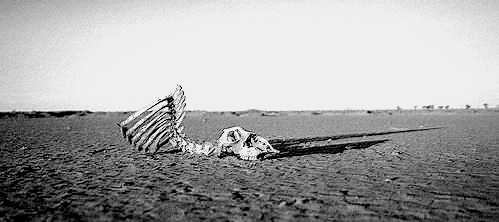
Lack of water is a problem that dates back to time immemorial for Australia, the world's driest land. If Australia's total annual run-off was spread evenly over the continent, the water depth would be a mere three centimetres.
Down the length of the eastern side of the continent, most of the water run-off from the Great Dividing Range flows eastwards into the Pacific Ocean and Tasman Sea, leaving the vast tracts of land on the western side of he ranges dry and prone to lasting drought. Evaporation in the hinterland is high and in dry seasons many tributaries to the main inland rivers, the Murray, Murrumbidgee, Lachlan and Darling become little more than chains of waterholes.
Time and again lack of water almost wreaked a cruel end to the early settlement of eastern Australia. In the years 1813-15 it was drought and the spectre of famine which added urgency to efforts to find a way over the Blue Mountains from the Sydney area.
Widespread drought struck again from 1824 to 1829, withering the newly discovered plains country. Crops burned, stock died and despite their familiarity with the land's natural resources, many Aboriginals were also reported to have perished through starvation. The familiar visitation of disaster struck again from 1837 to 1840 and even the snow-fed Murrumbidgee was dry in places, allowing settlers in some districts to run horse races on its bed. In 1843 good sheep were selling for three pence a head. The list of bankruptcies grew longer daily. The Bank of Australia failed. James Tyson, the king of the squatters, sold one run for a tot of rum and a second for twelve pounds which he never bothered to collect.
The infant industry resorted to the desperate expedient of boiling down sheep for tallow. The average sheep yielded twelve to fifteen pounds of tallow and tallow was worth five cents a pound -- at least for a while. By the end of 1844 more than two hundred thousand sheep had been boiled down and tallow prices began to fall.
Drought struck again in the late forties and for more than a decade from 1861 to 1870. Some graziers built dams on creeks and guarded them with armed men against reprisals from aggrieved landowners further downstream. In a dry season in 1858 parties of men destroyed or damaged more than twenty-five dams on the Yanko Creek, which runs between the Murrumbidgee and Murray Rivers.
Still the droughts continued, bringing pain and despair. Rainless seasons continued to strike randomly through to 1878, almost wiping out
whole pockets of the sheep and wool industry.
Then between 1895-1903 the so-called 'Federation drought' occurred.
The poet Henry Lawson has , avidly described the dire circumstances and plight of the farmer. His consternations were published in the newspaper " The Worker" in 1900 .
It appears from the writings of our pioneers that drought in Australia is a natural phenomenon that has to be endured by its inhabitants .
Partially Referenced from: 'SNOWY - The Making of Modern Australia' Author: Brad Collis
Most areas of Australia were drought-affected for long periods between 1958-1968.
It was the longest drought in arid central Australia from 1958-67. Australia-wide, during its last two years alone (1967-1968) there was a 40% drop in the wheat harvest, a loss of 20 million sheep,
and a decrease of farm income of up to $500m.
Event Start Date 01/01/1958 Event End Date 09/01/1968
Duration of Event 3896 days
Five million people were affected and a total loss of livestock was 40 million
METEOROLOGY OF AUSTRALIA
COMMONWEALTH BUREAU OF METEOROLOGY 1913
" ....the information for previous
years being rather too scanty for any adequate review of their peculiarities,
the principal drought years affecting the inland areas of South Australia,
Victoria, and New South Wales, were 1881, 1884, 1885, 1888, 1895, 1896,
1897, 1899, 1902, 1907, and 1911.
In considering drought years, attention
is directed rather to the failure of the rains during the critical periods for
grass and crops, which may be taken as extending from 1st April to 31st
October. The small annual rain totals for all but one of these constituted
them drought years in any case, the exception, and a very remarkable one,
being 1911, which, if the total rainfall alone is considered, stands out as one
of the wettest years on record for Victoria, owing to two tremendous rain-
falls in February and March. From July onward it was extremely dry,
as were also the first five months of 1912. The years 1884 and 1885 were
not universally bad, the former being very dry only in the eastern States,
and the latter in South Australia. " (6)
| Start Date | Drought in Australia | End Date | Duration days |
| 1857 | Longford, Tasmania | 1858 | 92 |
| 1863 | Oatlands, Tasmania: | ? | |
| 1864 | Drought source Year Book Australia (3) | 1866 | |
| 1868 | Drought source Year Book Australia | 1868 | |
| 1880 | Drought source Year Book Australia | 1886 | |
| 1888 | Drought source Year Book Australia | 1888 | |
| 1895 | Australia-Wide: Federation Drought | 1903 | 2921 |
| 1911 | Most States, Australia: Drought | 1916 | 1826 |
| 1918 | Most States, Australia: Drought | 1920 | 730 |
| 1939 | Most States, Australia: Drought | 1945 | 2192 |
| 1951 | Northern Australia: Drought | 1954 | 1096 |
| 1958 | Most States: Drought | 1968 | 3896 |
| 1982 | Eastern Australia: | 1983 | 334 |
| 1987 | Southern WA and SA: | 1988 | 152 |
| 1991 | Eastern and Northern Australia: | 1996 | 1826 |
| 1996 | Tasmania and Victoria: Drought | 2000 | 1461 |
| 1996 | Eastern and North-Western Tasmania: | 2001 | 1673 |
| 2000 | South-Western, WA: | 2001 | 366 |
Source: Emergency Management Australia http://www.ema.gov.au/
In the late 1930's and 1940's major droughts affected most of Australia. Nearly 30 million sheep died between 1942 and 1945.
Since the 1860s there have been 10 major Australian droughts.
Some of these major droughts could be described as periods consisting of a series of dry spells of various lengths, overlapping in time and space, and totalling up to about a decade.
The drought periods of 1895–1903 (the so-called ‘Federation drought’), 1958–68, 1982–83 and 1991–95 were the most devastating in terms of their extent and effects
on primary production.
The latter drought resulted in a possible $5b cost to Australia’s economy, and $590m in drought relief by the Commonwealth Government.
The remaining major droughts occurred in 1864–66 (and 1868), 1880–86, 1888, 1911–16, 1918–20 and 1939–45. In this same period, several droughts of lesser severity caused
significant losses over large areas of some states. They occurred in 1922–23 and 1926–29, 1933–38, 1946–49, 1951–52, 1970–72, 1976 and 1997–2000.
Source: 1301.0 - Year Book Australia, 1988 , 2006
Tasmania 2000
In March 2000, Central Highlands farmers said the worst drought since World War II was pushing them to the brink of despair. Some farmers believed their stock could be halved by the end of winter as the region endured its third consecutive year of drought.
Weather bureau figures showed that from October 1996 to almost mid-2001, the central and eastern region and the north-west of the State had experienced serious to severe rainfall deficiencies. From July to December 1999 almost all of the State experienced below normal rainfall levels and in parts of the South-East rainfall was the lowest on record.
The Tasmanian Department of Primary Industry, Water and Environment estimated that the drought had caused overall losses to the rural sector of sector of $50m from 1997 to 2000 with approximately $10 in 1997-98, $15m in 1998-99 and $25m in 1999-2000. (Another $10m was allowed for the remaining months of drought).
West Australia 2000
Not since the outbreak in WWI in 1914 had there been a drought so devastating in the eastern and northern wheatbelt.
A visit to the wheatbelt by the Minister of Agriculture in early July revealed an emerging tragedy in WA. The Minister said the drought was a tragedy of an enormous scale affecting one third of the Wheatbelt. He described the situation as "horrendous" and "sobering", a huge problem.
The Lakes District is at the heart of the worst affected area having recorded the lowest January to June rainfall on record. It was estimated only 70 per cent of crops had been planted and of those, about 50 per cent have germinated, with Western Australia facing a loss of up to $3 billion in total grain and livestock losses.
WA Agriculture minister Kim Chance estimated the drought will potentially cost the state $3 billion in livestock and cropping losses, depending on rainfall.
Source: Emergency Management Australia http://www.ema.gov.au/
The 2002–03 Drought
While not quite as dry over most of eastern Australia as those of 1901–02 or 1982–83, was
particularly severe in its impacts for two reasons.
First, it was accompanied by record high average maximum temperatures and, consequently, increased evaporation in many areas.
Secondly, it affected virtually the entire continent.
During earlier droughts the effects over Western Australia were more limited or non-existent.
The direct effect of the 2002–03 drought on agricultural production is that it had a downward impact on gross domestic product growth of almost one percentage point between 2001–02 and
2002–03 (see the article in the National Accounts chapter in Year Book Australia 2005).
Other notable droughts on the 1–2 year timescale include those of 1888, 1914, 1919–20, 1940–41, 1944, 1946, 1965, 1967 and 1972.
2002-06 Eastern and southern Australia is once again experiencing widespread drought, with agricultural income in 2006-07 expected to be at the lowest level since 1994-95.
 |
Latest Drought Updates.
September 18, 2008
For large parts of southern and eastern Australia, dry conditions have persisted since October 1996, a total of almost 12 years.
During the last 7 years in particular, the Murray-Darling Basin has experienced severe rainfall deficiencies, and from September 2001 to August 2008 was the 2nd driest seven-year period
(the driest was from 1939 to 1946).
Source: MDBC Murray System Drought Update No. 15 – September 2008 www.mdbc.gov.au
July 6, 2008
A joint assessment by the Bureau of Meteorology and the CSIRO, which found that what are now considered to be one in 25 year climate events could become as frequent as once every one to two
years.
In particular, the study found exceptionally high temperatures would occur almost yearly, while low rainfall would almost double in frequency from current figures.
Yearly Rain Totals for location 5 km west of Romsey,
Located 65 kilometres north west of Melbourne Australia.
Elevation 610 metres 2000 feet above sea level.


Reference:
(1) Source: MDBC Murray System Drought Update No. 15 – September 2008
www.mdbc.gov.au/__.../Drought_Update_Issue_15_-_September_2008.pdf, Retrieved 15/ 06/2009
(2) This image "Buggies and sulkies in the dry river bed of the River Murray at Myall near Kerang, Victoria." was digitally enhanced and converted to greyscale from the original which is located at the State Library of New South Wales. Reference McKernon, M. 2005, Drought – The red marauder, Allen and Unwin, Sydney.
(3) Source: Australian Bureau of Statistics –
1301.0 Year Book Australia 1988, http://www.abs.gov.au/ , Retrieved 12/06/2009.
(4) Source: Geoscience Australia - http://www.ga.gov.au/education/geoscience-basics/landforms/longest-rivers.jsp, Retrieved 15/ 06/2009
(5) Source: Image courtesy of the Commonwealth Bureau of Meteorology, Australia http://www.bom.gov.au
(6) Source: Image courtesy of UNSW Climate Change Research Centre
http://www.science.unsw.edu.au Accessed 08/04/2010.
(7) Source: The Indian Ocean Dipole. Commonwealth Bureau of Meteorology, Australia
http://www.bom.gov.au Accessed 08/04/2010.
(8) Source: University of New South Wales Climate Change Research Centre
http://www.science.unsw.edu.au Accessed 08/04/2010.
(9) Graph courtesy of the University of New South Wales Climate Change Research Centre
http://www.science.unsw.edu.au Accessed 08/04/2010.
(10) Image Source: The Tank Stream Sydney. The Coming of the British to Australia
1788 to 1829 by Ida Lee (Mrs. Charles Bruce Marriott) LONGMANS, GREEN, AND CO.
39 PATERNOSTER ROW, LONDON
NEW YORK AND BOMBAY
1906
Source: Indian Ocean causes Big Dry: drought mystery solved. Dr Caroline Ummenhofer and Professor Matthew England of the UNSW Climate Change Research Centre http://www.science.unsw.edu.au Accessed 08/04/2010.
Source: McKernon, M. Jan 2007, Past stories of people and drought in Australia,
http://www.abc.net.au/water/stories/s1836657.htm Retrieved 10 / 11 / 2008.
Reference: Saji N.H., Goswami B.N., Vinayachandran P.N., Yamagata T., 1999: A dipole mode in the tropical Indian Ocean, Nature, 401, 360-363.
Reference: About the Indian Ocean Dipole Climate Analysis Section, National Climate Centre,
Commonwealth Bureau of Meteorology, Australia http://www.bom.gov.au
Reference: Davidson, G.; McCarty, J.W. and McLeary, A. 1987, Australians 1888,
Fairfax, Syme and Weldon Assoc. Sydney.
Reference: Mortlock Library of South Australia: ‘The Great Drought – Lessons to be Learned’,
Observer, 10 December 1904, p13a.
Reference: COUGHLAN, M., D. JONES, N. PLUMMER,
A. WATKINS, B. TREWIN and S. DAWKINS,
2003: Impacts of 2002/2003 El Niño on
Australian climate. In: Proceedings of
DroughtCom Workshop: Improving the
Communication of Climate Information.
N. Plummer, M. Flannery, C. Mullen, B.
Trewin, A. Watkins, W. Wright, T.
Powell and S. Power (Eds), 2, 7-12.
Reference: Monthly Niño indices
ftp://ftpprd.ncep.noaa.gov/pub/cpc/wd52dg/data/indices/sstoi.indices
Reference: Nicholls, N. (2008) Recent trends in the seasonal
and temporal behaviour of the El Niño – Southern
Oscillation. Geophysical Research Letters 35:
Reference: Braganza, K., Gergis, J.L., Power, S.B.,
Risbey, J.S. and Fowler, A.M. (2009) A multiproxy
index of the El Niño – Southern Oscillation, A.D.
1525–1982. Journal of Geophysical Research 114:
Reference: Seidel, D., Fu, Q., Randel, W. and Reichler, T. (2008)
Widening of the tropical belt in a changing climate,
Nature Geoscience 1: 21–24.
Reference: Allan R. J. & D’Arrigo R. D. (1999) ‘Persistent’ ENSO
sequences: How unusual was the 1990–95 El Nino? Holocene
9, 101–18.
Reference: http://www.slsa.sa.gov.au/manning/sa/natdisas/fire.htm#droughts
Drought in Australia a natural phenomenon. (28 pages)
by Romsey Australia is licensed under a Creative Commons Attribution 2.5 Australia License.


Revised 03/01/2012